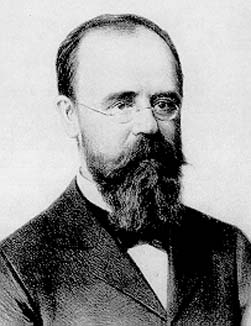


 تاريخ الرياضيات
تاريخ الرياضيات
 الرياضيات في الحضارات المختلفة
الرياضيات في الحضارات المختلفة 
 الرياضيات المتقطعة
الرياضيات المتقطعة
 الجبر
الجبر
 الهندسة
الهندسة 
 المعادلات التفاضلية و التكاملية
المعادلات التفاضلية و التكاملية 
 التحليل
التحليل
 علماء الرياضيات
علماء الرياضيات |
Read More
Date: 26-2-2017
Date: 20-2-2017
Date: 20-2-2017
|
Died: 22 August 1925 in Gnigl, near Salzburg, Austria

Emanuel Czuber's name is sometimes written as sometimes Cubr. He graduated from a German secondary school (Realschule) in 1869 and continued his studies at the German Technical University at Prague. There he played an active part in the Association for Free Lectures on Mathematics which was a student association and the predecessor of the Union of Czech Mathematicians and Physicists. From 1872 to 1874, while he was still a student, he acted as an assistant to Karel Koristka. He continued at the same position in 1875. He submitted his habilitation thesis on practical geometry (geodesy) to the Technical University at Prague in 1876 and obtained the right to lecture. From 1875 to 1886 he taught at the Second German Realschule in Prague. He married Johanna Liebleina in 1878 and their daughter Berta, born in 1879, married the younger brother of Franz Ferdinand d'Este, the successor to Austrian throne, in 1909. Sadly she died in 1916.
Czuber was appointed as an ordinary professor (equivalent to full professor in today's American system) at the German Technical University in Brno in 1886. In the academic year 1890-91 he was a Rector of the university. After the end of the academic year 1890-91 he took up an appointment as an ordinary professor at the Technical University in Vienna. The position became vacant when Anton Winckler applied for retirement and, although Czuber was not the first choice to fill the chair, other people who were put forward such as Moriz Allé and then Emil Weyr were not interested in accepting it. Czuber was Rector in the academic year 1894-95 and continued to hold the position of professor at Technical University of Vienna up to 1921 when he retired.
Among the topics Czuber studied was probability theory and related areas, contributing in 1900 to the Encyklopädie der mathematischen Wissenschaften. In fact he wrote the first papers with original results on the probability theory in the Czech region. A large part of his studies, however, was devoted to questions concerning actuHelvetica mathematics. He wrote several books (in German) such as Theorie der Beobachtungsfehler (1891), Die entwicklung der Wahrschinlichkeitstheorie und ihre Anwendungen (1898), Die Wahrschinlichkeitsrechnung und ihre Anwendungen auf Fehlerausgleichung . Statistik und Lebensversicherung(first edition 1903, second edition 1908, reprinted 1968), Die statistische Forschungsmethoden (1921), Die philosophischen Grundlagen der Wahrschinlichkeitsrechnung (1923), and Mathematische Bevölkerungstheorie (1923).
For several years he was an editor of Technische Blätter from 1876 to 1886. He also wrote some textbooks, for example Lehrbuch über Differential- und Integralrechnung (1898) and Einführung in die höhere Mathematik (1909). He translated a textbook Calcul des probabiliés which had been written by Franz A Meyer. On the other hand his book Wahrscheinlichkeiten und Mittelwerte (1884) was translated into French, although the translation was not published until 1902. As an author he was active right up to the end of his life.
He was honoured many times: at the age of 48 he was a "court advisor" (a special title typical for Austro-Hungarian Empire). He also received an honorary degree from the Technical University in Munich in 1918.
Articles:



|
|
|
|
دخلت غرفة فنسيت ماذا تريد من داخلها.. خبير يفسر الحالة
|
|
|
|
|
|
|
ثورة طبية.. ابتكار أصغر جهاز لتنظيم ضربات القلب في العالم
|
|
|
|
|
|
|
سماحة السيد الصافي يؤكد ضرورة تعريف المجتمعات بأهمية مبادئ أهل البيت (عليهم السلام) في إيجاد حلول للمشاكل الاجتماعية
|
|
|